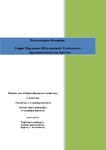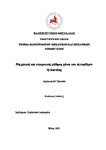Mostrar el registro sencillo del ítem
Prediction of Injuries in CrossFit Training: A Machine Learning Perspective
| dc.creator | Moustakidis S., Siouras A., Vassis K., Misiris I., Papageorgiou E., Tsaopoulos D. | en |
| dc.date.accessioned | 2023-01-31T09:02:11Z | |
| dc.date.available | 2023-01-31T09:02:11Z | |
| dc.date.issued | 2022 | |
| dc.identifier | 10.3390/a15030077 | |
| dc.identifier.issn | 19994893 | |
| dc.identifier.uri | http://hdl.handle.net/11615/76813 | |
| dc.description.abstract | CrossFit has gained recognition and interest among physically active populations being one of the most popular and rapidly growing exercise regimens worldwide. Due to the intense and repetitive nature of CrossFit, concerns have been raised over the potential injury risks that are associated with its training including rhabdomyolysis and musculoskeletal injuries. However, identification of risk factors for predicting injuries in CrossFit athletes has been limited by the absence of relevant big epidemiological studies. The main purpose of this paper is the identification of risk factors and the development of machine learning-based models using ensemble learning that can predict CrossFit injuries. To accomplish the aforementioned targets, a survey-based epidemiological study was conducted in Greece to collect data on musculoskeletal injuries in CrossFit practitioners. A Machine Learning (ML) pipeline was then implemented that involved data pre-processing, feature selection and well-known ML models. The performance of the proposed ML models was assessed using a comprehensive cross validation mechanism whereas a discussion on the nature of the selected features is also provided. An area under the curve (AUC) of 77.93% was achieved by the best ML model using ensemble learning (Adaboost) on the group of six selected risk factors. The effectiveness of the proposed approach was evaluated in a comparative analysis with respect to numerous performance metrics including accuracy, sensitivity, specificity, AUC and confusion matrices to confirm its clinical relevance. The results are the basis for the development of reliable tools for the prediction of injuries in CrossFit. © 2022 by the authors. Licensee MDPI, Basel, Switzerland. | en |
| dc.language.iso | en | en |
| dc.source | Algorithms | en |
| dc.source.uri | https://www.scopus.com/inward/record.uri?eid=2-s2.0-85125622051&doi=10.3390%2fa15030077&partnerID=40&md5=bac9e7a766ff293ac8de6ec0ea27353a | |
| dc.subject | Adaptive boosting | en |
| dc.subject | Data handling | en |
| dc.subject | Machine learning | en |
| dc.subject | Musculoskeletal system | en |
| dc.subject | Sports | en |
| dc.subject | Areas under the curves | en |
| dc.subject | Crossfit | en |
| dc.subject | Ensemble learning | en |
| dc.subject | Epidemiological studies | en |
| dc.subject | Identification of risks | en |
| dc.subject | Injury risk | en |
| dc.subject | Machine learning models | en |
| dc.subject | Machine-learning | en |
| dc.subject | Musculoskeletal injuries | en |
| dc.subject | Risk factors | en |
| dc.subject | Forecasting | en |
| dc.subject | MDPI | en |
| dc.title | Prediction of Injuries in CrossFit Training: A Machine Learning Perspective | en |
| dc.type | journalArticle | en |
Ficheros en el ítem
| Ficheros | Tamaño | Formato | Ver |
|---|---|---|---|
|
No hay ficheros asociados a este ítem. |
|||

